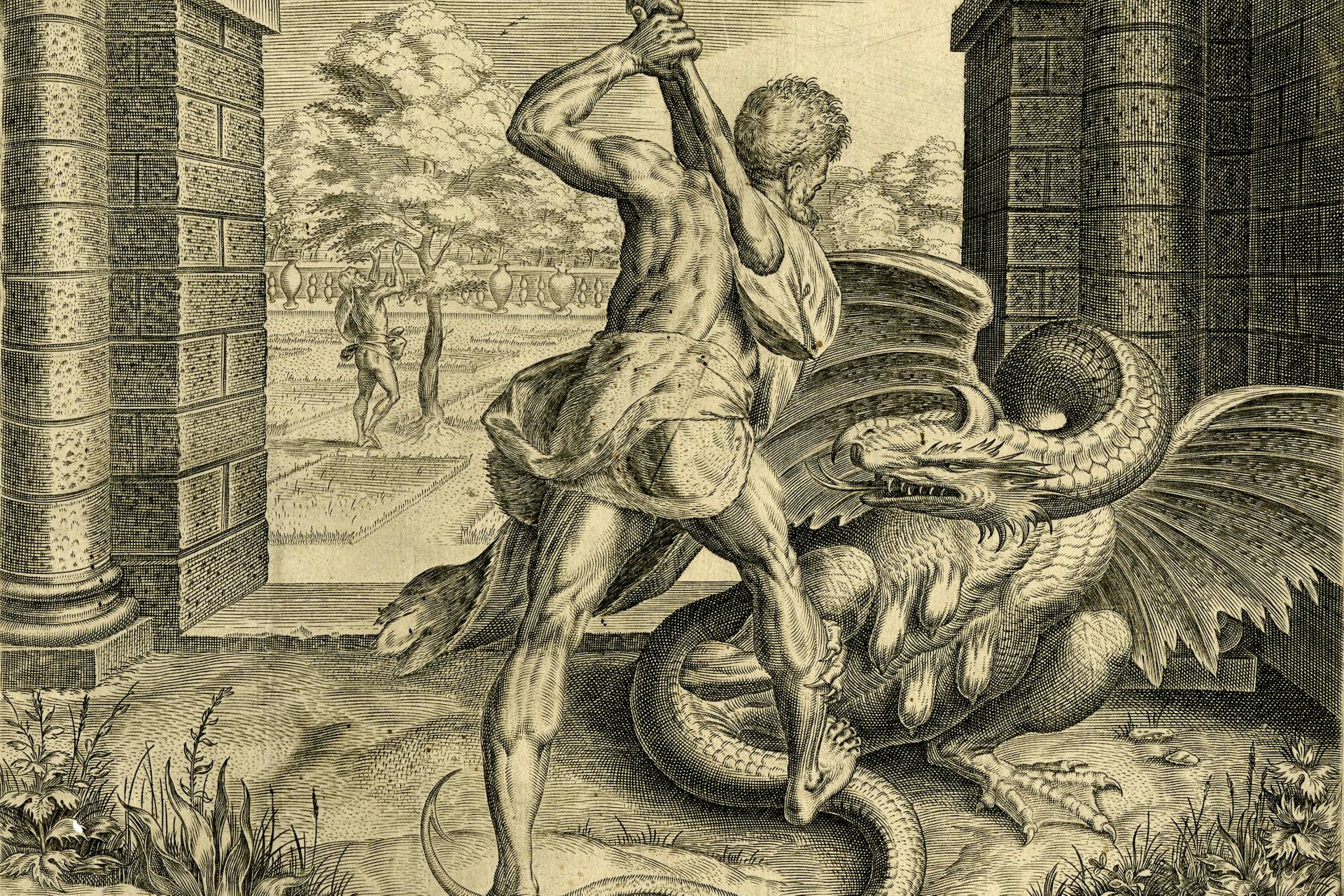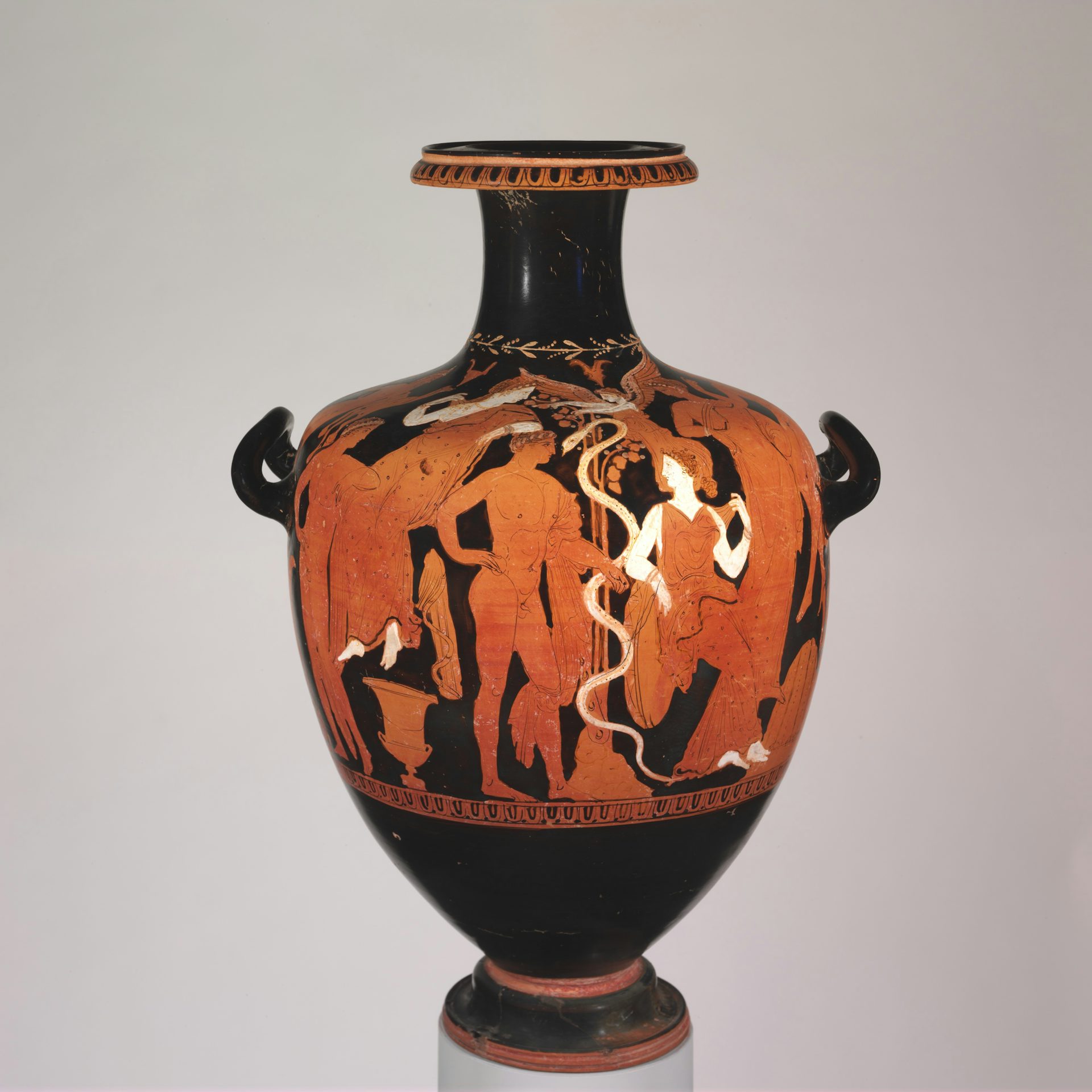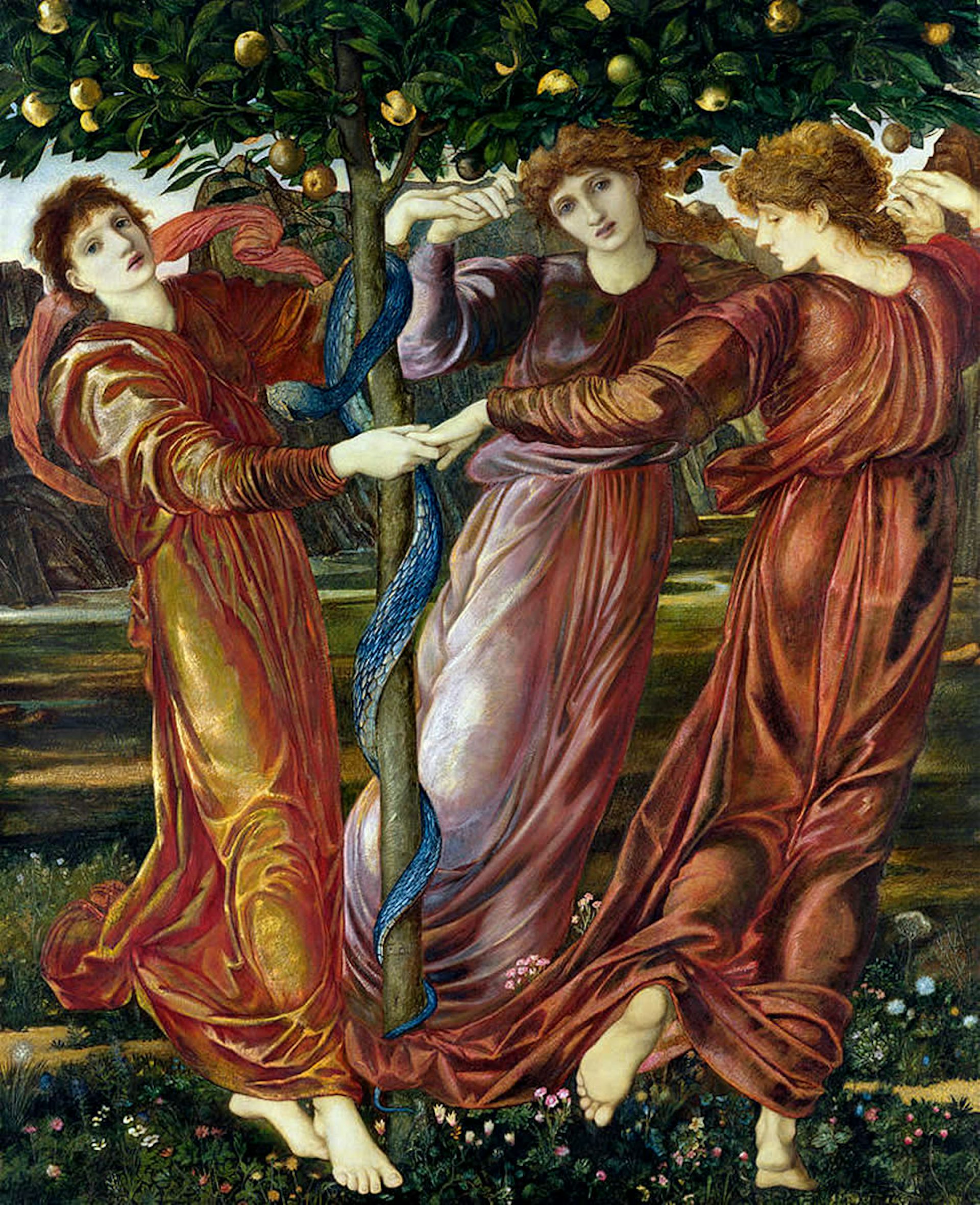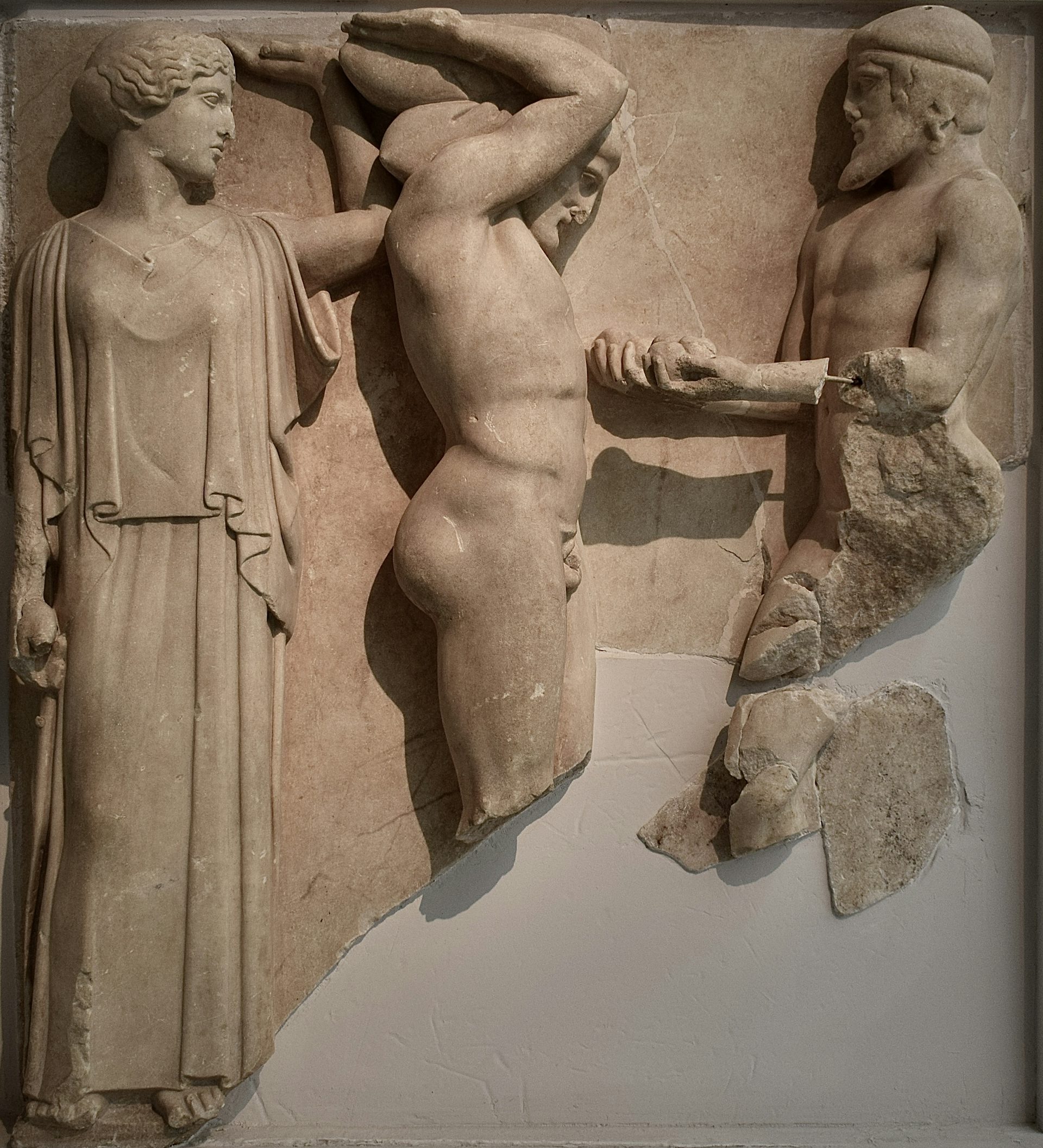Ladon

Hercules slaying the dragon Ladon by Cornelis Cort, after Frans Floris (1563).
British MuseumPublic DomainOverview
Ladon was the name sometimes given to the terrible serpent that guarded the Garden of the Hesperides. His main duty was to ensure that no one stole the famous golden apples of the Hesperides, which were hidden away in this remote garden. Ladon was assisted in this task by the nymphs known as the Hesperides.
When the hero Heracles was sent to fetch the golden apples as one of his Twelve Labors, he needed to find a way past the fearsome Ladon. In some traditions, Heracles simply killed the serpent, but in others he convinced the Titan Atlas, sometimes said to be the father of the Hesperides, to have his daughters give him the apples.
Etymology
The name “Ladon” (Greek Λάδων, translit. Ládōn) rarely appears in ancient sources.[1] Most accounts refer to the serpent that guarded the Garden of the Hesperides simply as ὄφις (óphis) or δράκων (drákōn), generic words meaning “snake.”
Because Ladon’s name is so uncommon, its etymology is obscure. It does, however, resemble the names of other snakes and dragons of Greek myth, which tend to exhibit a similar “-on” ending; examples include Typhon (also called Typhoeus), Python, and Glycon (as well as the generic Greek word drákōn, mentioned above).
Pronunciation
English
Greek
Ladon Λάδων (translit. Ládōn) Phonetic
IPA
[LEYD-n] /ˈleɪd n/
Attributes
General
Ladon guarded the Garden of the Hesperides—and in particular, the golden apples hidden there. This garden was usually placed somewhere in the West, either near Atlas and the Atlas Mountains,[2] the “land of the Aethiopians,”[3] Libya,[4] or the remotest corner of Africa.[5] Other sources, however, located the garden in the Far North, near the land of the Hyperboreans.[6] Some sources were more vague about the location, saying that it was somewhere beyond Oceanus, possibly even beneath the earth[7] or at the end of the world.[8]
Ladon was a serpent of notable size—the equivalent, perhaps, of what we would now call a “dragon.” In one tradition, he had one hundred heads and many terrifying voices, much like the monster Typhoeus.[9] But this seems to have been an idiosyncratic description, with most sources representing Ladon with only one head (though some early artistic representations did give him as many as two or three).
Ladon was also described as having a tawny back,[10] and a few sources reported that he never slept.[11] The mythographer Apollodorus upgraded Ladon’s sleeplessness to immortality.[12] Ladon was sometimes identified with the constellation Draco (also called Ophis by the Greeks).[13]
Iconography
By the mid-sixth century BCE, Ladon was a popular subject in the visual arts, appearing in works that were famous in antiquity but that unfortunately have not survived. These included a wooden statue group created by Theocles for the Treasury of the Epidamnians in Olympia, which showed the serpent coiled around the golden apple tree in the Garden of the Hesperides.[14]

Attic red-figure hydria by the Hesperides Painter showing Heracles in the Garden of the Hesperides, with women, a satyr, Pan, and the serpent Ladon wrapped around the apple tree (early fourth century BCE).
Metropolitan Museum of ArtPublic DomainIn surviving art, Ladon is typically shown in the Garden of the Hesperides. A number of vases from South Italy feature Ladon together with the Hesperides or being fed by the Hesperides. In some depictions, he is represented fighting Heracles, but in others Heracles apparently avoided the serpent by sending Atlas to fetch the apples for him.[15]
Family
Family Tree
Mythology
The Garden of the Hesperides
Ladon was the dreaded guardian of the Garden of the Hesperides. In what was probably the best-known tradition, this remote garden housed the golden apples that Gaia, the primordial goddess of the earth, had given to Hera as a wedding gift when she married Zeus.[19] In another tradition, the apples belonged to the nymphs of the garden, the Hesperides.[20] But in one source, the garden actually belonged to the Titan Atlas, who set Ladon as the guardian of the apples after he learned from an oracle that they were destined to be stolen.[21]

The Garden of the Hesperides by Edward Burne-Jones (ca. 1869).
Hamburger Kunsthalle, Hamburger, GermanyPublic DomainLadon’s companions were the nymphs known as the Hesperides, often said to have been daughters of Atlas. These beautiful nymphs tended to the garden and, in some traditions, helped Ladon guard it.[22] But in one account, Hera had commanded Ladon to protect the apples from the Hesperides because they kept picking and stealing them.[23] In another tradition, Ladon guarded the apples from Aphrodite, who had picked three apples to help her mortal favorite Hippomenes seduce Atalanta.[24]
In addition to tending the garden, the Hesperides were sometimes said to feed Ladon as well. According to Virgil, one of the Hesperides “supplied the wakeful dragon’s fare” and “poppy seeds in honey taught to steep.”[25] This may be a hint that the Hesperides used to drug Ladon so that they could steal the apples while he was asleep.[26]
The Eleventh Labor of Heracles
One of Heracles’ renowned Twelve Labors—either the eleventh or twelfth labor, depending on the source—was to fetch the golden apples from the Garden of the Hesperides.
Though the garden was tucked away in a secret and distant corner of the world, Heracles soon found it with the help of the nymphs of Eridanus. These nymphs sent Heracles to Nereus, the Old Man of the Sea, who alone knew the location of the garden. Heracles wrestled Nereus for information, who transformed into many different forms in an attempt to escape; but Heracles held on, and Nereus was finally forced to reveal the whereabouts of the Garden of the Hesperides.
Accounts of how Heracles acquired the golden apples from the Garden of the Hesperides can be divided into (at least) two groups.
In one tradition, Heracles used cunning rather than brawn to acquire the apples. Shrinking from a fight with the serpent Ladon (an uncharacteristic move for the hero), Heracles convinced Atlas to get the apples for him instead.

One of the metopes from the Temple of Zeus at Olympia, representing Heracles’ eleventh Labor, with Heracles holding up the sky as Atlas brings him the golden apples from the Garden of the Hesperides (early fifth century BCE). Archaeological Museum, Olympia, Greece.
Jean HousenCC BY-SA 4.0Atlas, the Titan whom Zeus had forced to carry the heavens upon his shoulders, was usually said to have been the father of the Hesperides, the nymphs who watched over the golden apples. Heracles thus offered to place the heavens on his own shoulders while Atlas fetched the apples from his daughters.[27]
In another tradition, Heracles did fight the terrible Ladon. In some accounts, he merely put the serpent to sleep.[28] But in others, Heracles managed to kill Ladon, after which he snatched the golden apples and left.[29] Apollonius of Rhodes paints a powerful picture of the Hesperides mourning the fallen Ladon, who was struck down by Heracles’ infamous arrows, tipped with the poisonous blood of the Hydra:
stricken by Heracles, he lay fallen by the trunk of the apple-tree; only the tip of his tail was still writhing; but from his head down his dark spine he lay lifeless; and where the arrows had left in his blood the bitter gall of the Lernaean hydra, flies withered and died over the festering wounds. And close at hand the Hesperides, their white arms flung over their golden heads, lamented shrilly; and the heroes drew near suddenly; but the maidens, at their quick approach, at once became dust and earth where they stood.[30]
According to some ancient authors, Hera took the fallen Ladon and put him in the stars as the constellation Ladon. Nearby was another constellation, called Engonasin (“the Kneeler”) by the Greeks, which was said to represent Heracles.[31]